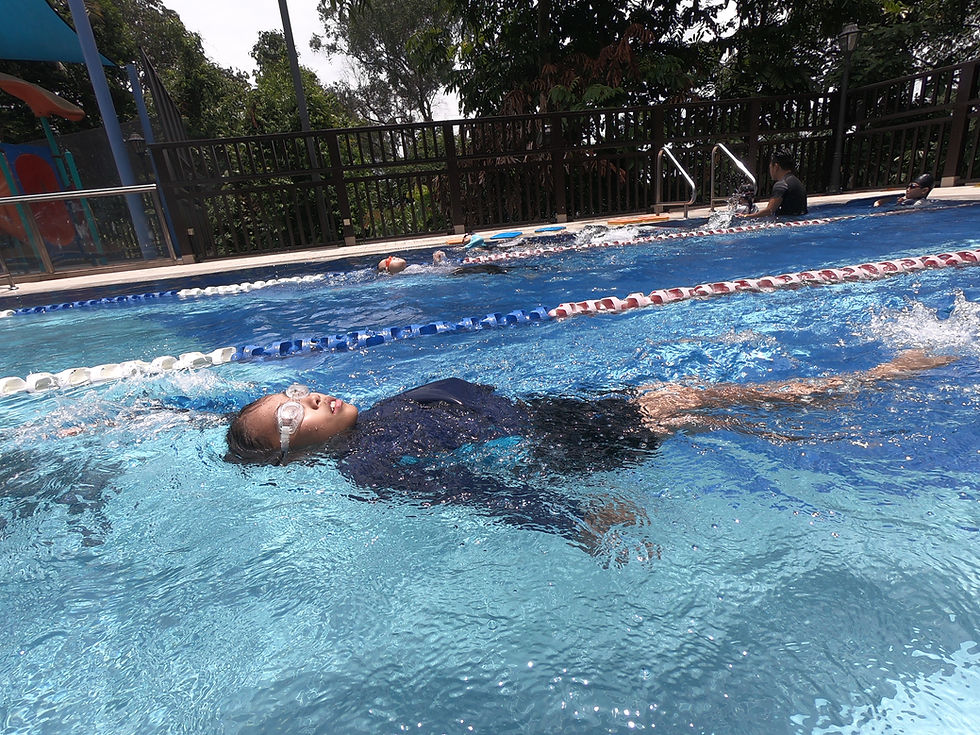How to Swim Backstroke Without Splashing Excessively
- SG Sink Or Swim

- Aug 3
- 3 min read

Backstroke is known for its graceful, flowing motion — but if you’re kicking up too much water, splashing with your hands, or creating turbulence, it’s likely costing you energy, speed, and efficiency. Excessive splashing is a sign that your backstroke technique needs refinement.
In this article, we’ll break down why splashing happens, how it affects your swim, and — most importantly — how to correct it so your backstroke becomes smoother, faster, and more hydrodynamic.
💦 Why Excessive Splashing Happens in Backstroke
Common causes of splash-heavy backstroke include:
Incorrect hand entry (slapping or flat hands instead of slicing in)
Overbending the knees during the kick
Kicking from the knees instead of the hips
Crossing arms over the centerline
Over-rotation of the torso
These mistakes disrupt streamline and create unnecessary resistance.
🧠 How Splash Impacts Performance
Too much splashing can:
Slow you down by increasing drag
Waste energy that should be used for propulsion
Throw off your body position and balance
Create a jerky, uneven stroke rhythm
To swim clean backstroke, you need to focus on precision, control, and alignment.
✅ Techniques to Reduce Splash in Backstroke
1. Refine Your Hand Entry
Enter the water pinky-first, just outside the shoulder line
Avoid slapping the water or crossing midline
Keep your arm relaxed and straight during the recovery phase
💡 Imagine slicing the water with a knife instead of slapping it with a paddle.
2. Kick from the Hips, Not the Knees
Use small, fast, hip-driven kicks
Keep your knees slightly bent but avoid exaggerated motion
To test this, try swimming with a pull buoy to isolate the legs and feel the motion
✅ Controlled kicks = less turbulence and more propulsion.
3. Control Your Body Rotation
Over-rotation causes your arms and hands to enter at awkward angles
Aim for shoulder rotation, not full body rolling
Use a stable head position (eyes up, chin slightly tucked)
🔄 Think of rolling "through the shoulders," not the waist.
4. Use Clean Arm Recovery
Let your arms recover over the water in a straight, relaxed motion
Avoid flinging them or throwing them into the water
Keep your wrist and fingers loose until just before the hand enters the water
🛠️ Practice "zipper drills" to build smoother arm recovery patterns.
5. Keep a Balanced, Streamlined Bodyline
Head still, hips high, eyes to the sky
Engage your core to stay aligned and reduce drag
Avoid lifting your chest or hips too high out of the water
🎯 Streamlining helps everything — less splash, better speed, and reduced effort.
🏊♀️ Drills to Practice Quiet Backstroke
🔹 Pinky Drill
Swim 25m focusing only on entering the water with the pinky first. Minimal splash should be the goal.
🔹 Kicking with Hands at Sides
Lie back and kick without using arms. Focus on small, steady flutter kicks that create minimal surface disruption.
🔹 Single-Arm Backstroke
Swim with one arm at your side and the other doing the full stroke. Helps isolate and improve entry and recovery motion.
🔹 6-3-6 Drill
6 kicks in streamlined back float
3 full backstroke arm strokes
6 kicks again
Builds balance and control throughout the stroke cycle.
🧭 Quick Fix Checklist
Am I entering pinky-first?
Are my kicks small and fast from the hips?
Is my bodyline straight and stable?
Am I using controlled arm recovery?
Is my rotation smooth, not exaggerated?
🏁 Final Thoughts
Backstroke doesn’t have to look or feel chaotic. When you eliminate unnecessary splash, your stroke becomes more energy-efficient, powerful, and elegant. Focus on small adjustments, practice the right drills, and stay mindful of your body mechanics.
Smooth = fast. Silent = strong.





Comments